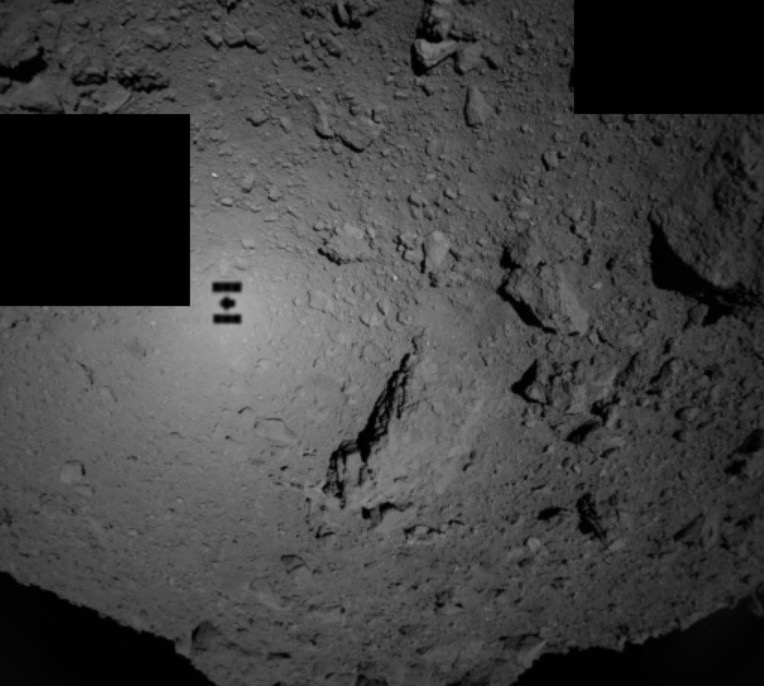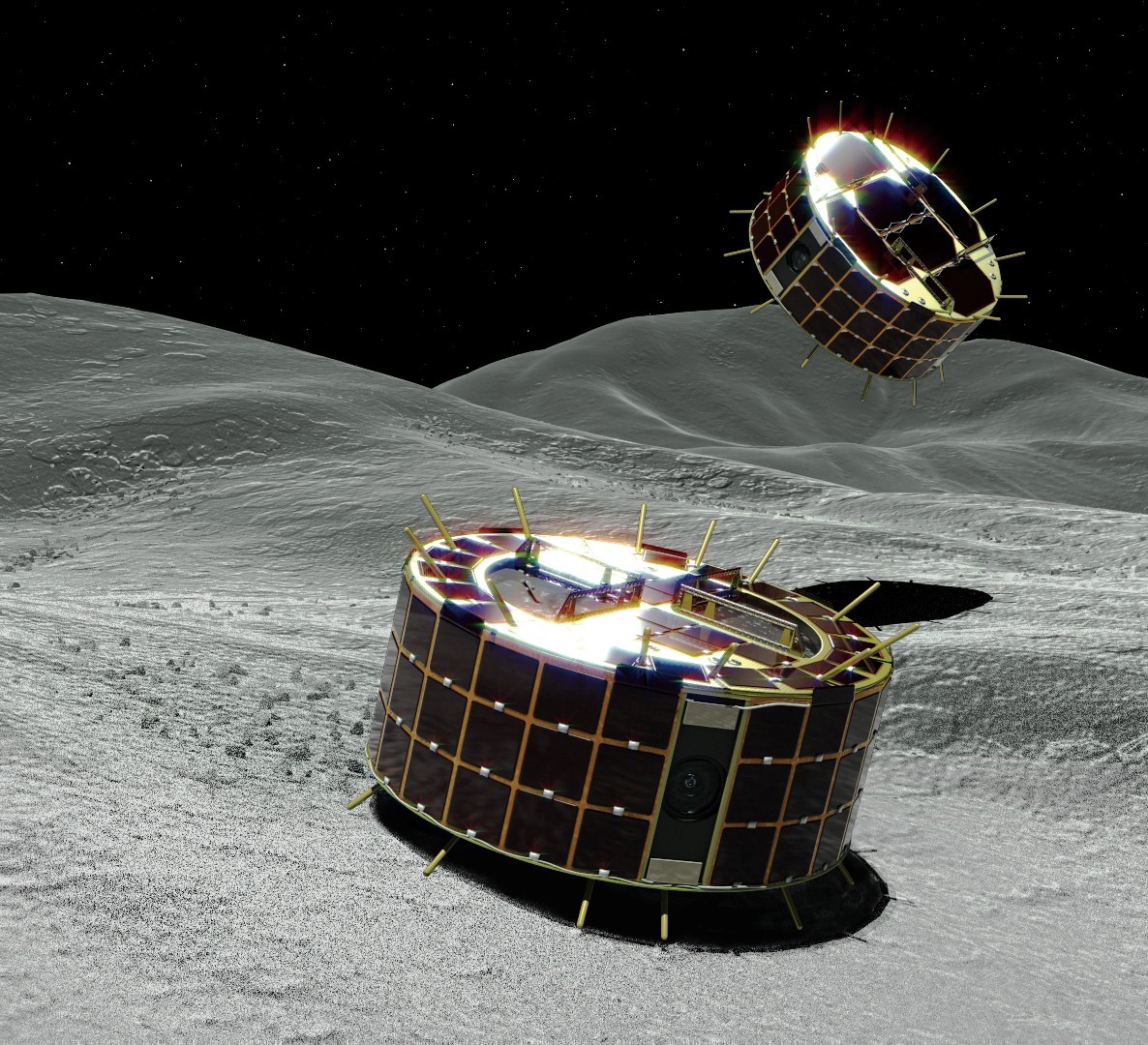Two tiny hopping robots have begun their historic attempt to land on a big asteroid in deep space.
Japan's Hayabusa2 probe, which has been circling the 3,000-foot-wide (900 meters) asteroid Ryugu since late June, deployed two little "rovers" called MINERVA-II1A and MINERVA-II1B at 12:06 a.m. EDT (0406 GMT) today (Sept. 21). The event occurred when the mother ship was about 180 feet (55 meters) above Ryugu's pockmarked, boulder-strewn surface, mission team members said.
"The separation of MINERVA-II1 has been confirmed! The state of the spacecraft is normal," JAXA officials announced via Twitter just after the rovers deployed. That confirmation came after an apparently tense descent for Hayabusa2 flight controllers. "In the control room, you can hear the sound of deep breaths around the room," JAXA officials wrote just before the rovers were released. [Japan's Hayabusa2 Asteroid Ryugu Sample-Return Mission in Pictures]

JAXA officials confirmed a clear signal from the MINERVA-II1 rovers after they were deployed, but did lose contact due to asteroid Ryugu's rotation before they could confirm any images from the landing itself.
"This is probably due to the rotation to Ryugu, and MINERVA-II1 is now on the far side of the asteroid," JAXA officials said. "We are currently working to confirm if there are images capturing the MINERVA-II1 landing."
If everything goes according to plan, the 2.4-lb. (1.1 kilograms) robots will soon join a very select club. To date, the only craft to pull off a soft touchdown on an asteroid are NASA's Near Earth Asteroid Rendezvous-Shoemaker spacecraft, which landed on Eros in 2001, and the original Hayabusa probe, which stayed for a brief spell on the surface of Itokawa in 2005. (Only one mission has ever executed a soft landing on a comet: In November 2014, the European Space Agency's Rosetta orbiter dropped a lander called Philae onto 67P/Churyumov-Gerasimenko.)
MINERVA-II1A and MINERVA-II1B are 7 inches wide by 2.8 inches tall (18 by 7 centimeters) and tote a variety of scientific gear, including temperature and optical sensors and a total of seven cameras. Though the Hayabusa2 team calls them rovers, the bantam craft won't roll along like the Mars explorer Curiosity; rather, MINERVA-II1A and MINERVA-II1B will hop from place to place on Ryugu's surface, thanks to internal rotating motors.
Get the Space.com Newsletter
Breaking space news, the latest updates on rocket launches, skywatching events and more!
"Gravity on the surface of Ryugu is very weak, so a rover propelled by normal wheels or crawlers would float upwards as soon as it started to move," mission team members wrote in a MINERVA-II1 description.
"Therefore, this hopping mechanism was adopted for moving across the surface of such small celestial bodies," they added. "The rover is expected to remain in the air for up to 15 minutes after a single hop before landing, and to move up to 15 m [50 feet] horizontally."

MINERVA-II1A and MINERVA-II1B will perform these exploration leaps autonomously, figuring out for themselves where they should go next, Hayabusa2 team members have said.
This morning's maneuver kicks off an ambitious Ryugu surface-exploration campaign for the $150 million Hayabusa2 mission, which launched in December 2014. In early October, the orbiter will deploy an instrument-packed 22-lb. (10 kg) lander called MASCOT, which was built by the German Aerospace Center in collaboration with the French space agency CNES. And sometime next year, another little hopper, MINERVA-II2, will touch down on Ryugu as well.
The Hayabusa2 mother ship will also spiral down to the asteroid's surface in 2019, snagging samples from a fresh crater it will blast out with a (nonexplosive) impactor. This pristine, previously subsurface material is scheduled to come to Earth in a special return capsule in December 2020.
Scientists in labs around the world will then scrutinize this cosmic dirt and gravel, learning more about the solar system's early days and the role carbon-rich asteroids like Ryugu may have played in delivering water and the chemical building blocks of life to the early Earth, Japan Aerospace Exploration Agency (JAXA) officials have said.
"MINERVA" is short for "Micro Nano Experimental Robot Vehicle for Asteroid." The original MINERVA hopper flew aboard JAXA's Hayabusa mission, which arrived in orbit around Itokawa in 2005 and returned a tiny sample of the space rock to Earth in 2010; those previous missions explain the "MINERVA-II" naming system for Hayabusa2. (MINERVA did not succeed in its Itokawa touchdown try more than a decade ago.)
"MASCOT," by the way, stands for "Mobile Asteroid Surface Scout."
Hayabusa2 isn't the only asteroid-sampling mission operating in deep space. NASA's OSIRIS-REx probe is in the home stretch of its journey to the 1,640-foot-wide (500 meters) asteroid Bennu; the spacecraft is scheduled to arrive at Bennu on Dec. 3 and slip into orbit around the space rock on Dec. 31.
If all goes according to plan, OSIRIS-REx (which is short for "Origins, Spectral Interpretation, Resource Identification, Security-Regolith Explorer") will grab a Bennu sample in mid-2020, and this material will parachute down to Earth in September 2023. The mission's goals broadly align with those of Hayabusa2.
Editor's note: This story has been updated to include new updates on the Hayabusa2 rover landing progress from the Japan Aerospace Exploration Agency, including a new time of release. It was 12:06 a.m. EDT, one minute later than initially reported.
Follow Mike Wall on Twitter @michaeldwall and Google+. Follow us @Spacedotcom, Facebook or Google+. Originally published on Space.com.
Join our Space Forums to keep talking space on the latest missions, night sky and more! And if you have a news tip, correction or comment, let us know at: community@space.com.

Michael Wall is a Senior Space Writer with Space.com and joined the team in 2010. He primarily covers exoplanets, spaceflight and military space, but has been known to dabble in the space art beat. His book about the search for alien life, "Out There," was published on Nov. 13, 2018. Before becoming a science writer, Michael worked as a herpetologist and wildlife biologist. He has a Ph.D. in evolutionary biology from the University of Sydney, Australia, a bachelor's degree from the University of Arizona, and a graduate certificate in science writing from the University of California, Santa Cruz. To find out what his latest project is, you can follow Michael on Twitter.









